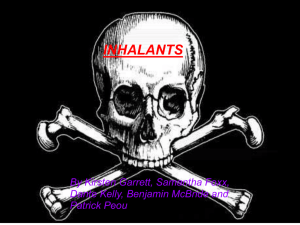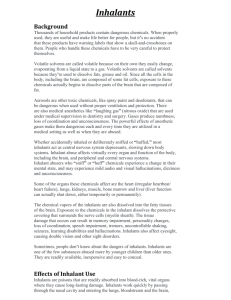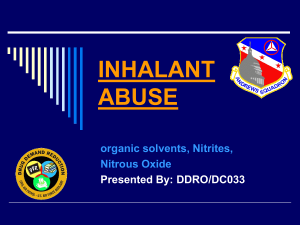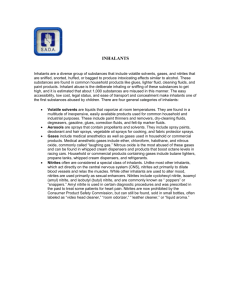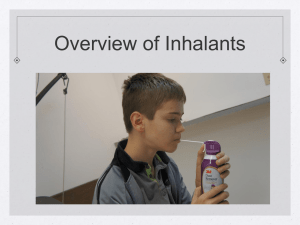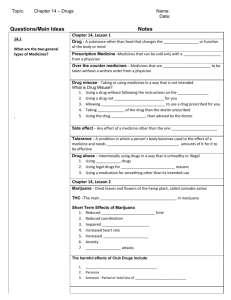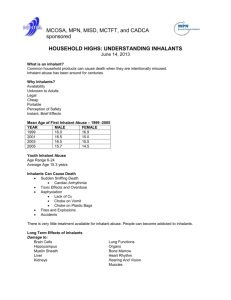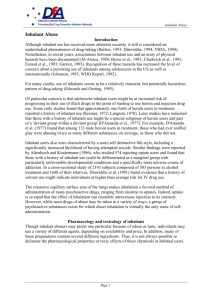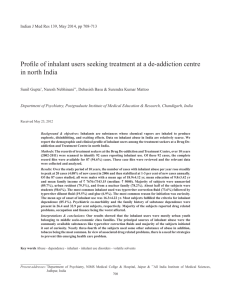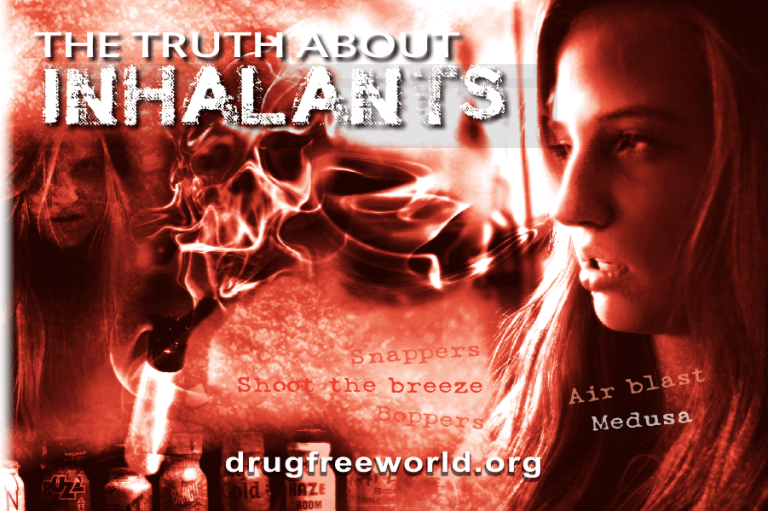
the truth about
Snappers
Shoot the breeze
Boppers
drugfreeworld.org
t
blas
Air
Medusa
WHY THIS BOOKLET
WAS PRODUCED
T
here is a lot of talk about drugs in the world—on the streets, at school,
on the Internet and TV. Some of it is true, some not.
Much of what you hear about drugs actually comes from those selling
them. Reformed drug dealers have confessed they would have said
anything to get others to buy drugs.
Don’t be fooled. You need facts to avoid becoming hooked on drugs and
to help your friends stay off them. That is why we have prepared this
booklet—for you.
Your feedback is important to us, so we look forward to hearing from
you. You can visit us on the web at drugfreeworld.org and e‑mail us
at info@drugfreeworld.org.
2
W h a t a r e In h a l a n t s ?
I
nhalants” refers to the vapors from
toxic substances which are inhaled to
reach a quick high. Of more than 1,000
household and other common products
that could be abused as inhalants, most
often used are shoe polish, glue, toluene,*
gasoline, lighter fluid, nitrous oxide† or
“whippets,” spray paint, correction fluid,
cleaning fluid, amyl nitrite‡ or “poppers,”
locker room deodorizers or “rush,” and
lacquer thinner or other paint solvents.
Most of these produce effects similar
to anesthetics, which slow down the
body’s functions. After an initial high
and loss of inhibition comes drowsiness,
light‑headedness and agitation.
sometimes causing irreversible physical
and mental damage.
Users inhale the chemical vapors
directly from open containers (“sniffing”)
or breathe the fumes from rags soaked
in chemicals (“huffing”). Some spray
the substance directly into the nose
or mouth, or pour it onto their collar,
sleeves or cuffs and sniff them
periodically. In “bagging,” the user
may inhale fumes from substances
inside a paper or plastic bag. Bagging
in a closed area greatly increases the
chances of suffocation.
The chemicals are rapidly absorbed
through the lungs into the bloodstream and
quickly reach the brain and other organs,
“Poppers” and “whippets,” sold
at concerts and dance clubs, are
composed of poisonous chemicals
that can permanently damage the
body and brain.
* toluene: a colorless liquid used as a solvent and a fuel.
†nitrous oxide: a colorless, sweet‑smelling gas used as
an anesthetic.
‡amyl nitrite: a pale yellow liquid used to open
or widen blood vessels, sometimes abused as
an inhalant.
3
Street names
f o r in h a l a n t s
7 Air blast
7 Highball
7 Satan’s secret
7 Ames
7 Hippie crack
7 Shoot the
breeze
7 Amys
7 Huff
7 Snappers
4
7 Aroma of men
7 Laughing gas
7 Snotballs
7 Bolt
7 Locker room
7 Spray
7 Boppers
7 Medusa
7 Texas shoe shine
7 Bullet
7 Moon gas
7 Thrust
7 Bullet bolt
7 Oz
7 Toilet water
7 Buzz bomb
7 Pearls
7 Toncho
7 Discorama
7 Poor man’s pot
7 Whippets
7 Hardware
7 Poppers
7 Whiteout
7 Heart‑on
7 Quicksilver
7 Hiagra in a
bottle
7 Rush snappers
I
t was a steady progression from
glue sniffing, gas sniffing, magic
mushrooms, that went on until I was
17. Then I started on cannabis. I was
spending my money on as much
cannabis as I could get my hands on.
Then I was old enough to go into the
clubs, so I started there on amphetamines
and Ecstasy. . . .
“I began hanging out with people who were
taking heroin, and soon I was using it more
and more until I was addicted. I had no idea
then the damage it would cause me later . . . that I would be serving one prison sentence
after another, burglarizing people’s houses,
stealing from my family. All the pain and
heartache that I have caused was worse
than stealing the material things from
them.” — Dennis
5
W
hen I was in fourth grade
a so‑called friend of mine
introduced me to inhalants. Being
so young and not knowing any
better, I started huffing gas
every day all the way up to
my eighth grade year. My
motor function skills are
pretty much shot and I
sit for hours on end
just staring into
space without a
single thought
even crossing
my mind.
It’s like my
body is
here but
6
I am not. I have a
hard time holding
down jobs and I have
been living by myself
now for twelve years.
I look normal
from the outside
but when I try to
show interest and
talk to women, it
becomes apparent
that I am pretty much
a vegetable. I am sick
of living this way and I would
rather be dead than to live my life
like this anymore, because it seems
like I’m already dead anyway.”
— John
how do inha
lants
af f ec t yo u r bo dy ?
I
nhalant use can cause
damage to the heart, kidneys,
brain, liver, bone marrow and
other organs.
7 Inhalants starve the body of
oxygen and force the heart
to beat irregularly and more
rapidly.
7 Users can experience nausea
and nosebleeds and lose their
sense of hearing or smell.
Chronic use can lead to muscle
wasting and reduced muscle
tone, and the poisonous
chemicals gradually damage
the lungs and the immune
system.
7 An inhalant user risks Sudden
Sniffing Death Syndrome.
Death can occur the first
time or the 100th time an
inhalant is used.
7
short - term effects
M
ost inhalants act directly on the nervous system to produce
mind‑altering effects. Within seconds, the user experiences
intoxication and other effects similar to those from alcohol.
There are a variety of effects that may be experienced during
or shortly after use, including:
7 Prolonged sniffing of
7 Slurred speech
these chemicals can
7 Drunk, dizzy or dazed
induce irregular and
appearance
rapid heart beat and
7 Inability to coordinate
lead to heart failure
movement
and death within
7 Hallucinations and
minutes.
delusions
7 Death from suffocation
7 Hostility
can occur by replacing
7 Apathy
oxygen in the lungs
7 Impaired judgment
with the chemical,
7 Unconsciousness
and then in the central
7 Severe headaches
7 Rashes around the nose nervous system, so that
breathing ceases.
and mouth
8
long - term effects
Long‑term users have
experienced:
7 Muscle weakness
7 Disorientation
7 Lack of coordination
7 Irritability
7 Depression
7 Serious and sometimes irreversible
damage to the heart, liver, kidneys,
lungs and brain
7 Memory impairment,
diminished intelligence
7 Hearing loss
7 Bone marrow damage
7 Deaths from heart
failure or asphyxiation
(loss of oxygen)
C
hronic exposure to inhalants can
produce significant, sometimes
irreversible, damage to the heart,
lungs, liver and kidneys.
The chronic use of inhalants has been
associated with a number of serious health
problems. Sniffing glue and paint thinner
causes kidney problems. Sniffing toluene
and other solvents causes liver damage.
Inhalant abuse has also resulted in memory
impairment and diminished intelligence.
9
T
omorrow is the sixth anniversary of
our son Justin’s death. He was 16. He
died from inhaling air freshener, an act
of inhalant abuse. His senseless death
rocked the worlds of all who knew
him. Justin was an honors student
who loved life and embraced it
with enthusiasm. . . . He was
a source of inspiration for
many. . . . I will always be
haunted by the question
of whether Justin would
be with us today had he
known about the risks
he was taking.”
— Jackie
10
are inhalants a d d i c
tive?
nhalants can be physically
I
and psychologically addictive. Users
report a strong urge to continue using inhalants,
especially after continued usage over many days.
Habitual users coming off inhalants suffer
withdrawal symptoms which can include
nausea, excessive sweating, muscle cramps,
headaches, chills, agitation, with shaking and
hallucinations. In severe cases, withdrawal can
cause convulsions.
in t e r n a t io n a l
s t a t is t ic s
A
US survey, combining data from 2002 to 2006, found that an
annual average of 593,000 teens aged 12 to 17 had used inhalants
for the first time in the year before they took the survey.
7 More than 22.9 million Americans have experimented with
inhalants at some point in their lives.
7 One state in the US averaged more than 3,800 emergency
room visits and 450 hospitalizations a year due
to inhalant poisonings, according to statistics
released in 2008.
7 By the time students in the US reach the 8th grade,
one in five will have used inhalants. In 2007, inhalants
were the substance most frequently abused by youth
aged 12 or 13.
7 22% of inhalant abusers who died of Sudden
Sniffing Death Syndrome had no history of previous
inhalant abuse—they were first‑time users.
12
7According to the European School
Project on Alcohol and Other Drugs,
20% of youth in the 12 to 16 age group
have tried inhalants.
7 In Nairobi, Kenya, an estimated
60,000 children live on the streets and
almost all are addicted to some sort of
inhalant.
22% of inhalant
In Karachi,
abusers who
Pakistan,
80% to 90%
died had
of street kids
no history
of previous
sniff glue or
inhalant
solvents.
abuse.
80 ‑ 9
0%
7 In the Pakistani city of Karachi there
are an estimated 14,000 street kids,
of whom 80% to 90% sniff glue
or solvents.
7 In the US, the 2006 National Survey
on Drug Use and Health found that
1.1 million youths aged 12 to 17 had
used inhalants in the past year.
22%
13
F
or three days, a friend gave me glue
free of cost. On the fourth day he
asked for money from me. By then, I was
addicted and I had to give him money to
get a tube of glue. I needed several tubes
of glue daily.” — Marty
14
Di f f e r e n t t y p e s
o f in h a l a n t s
Inhalants can be categorized into four different types:
ids
that vaporize at room temperatures. These are found in
numerous easily available household and industrial products
including paint thinners, degreasers, gasoline, glues, correction
fluids and felt‑tip marker fluids.
liqu
sprays
such as spray paints, deodorant and hair sprays,
vegetable oil sprays for cooking and fabric protector sprays.
including medical anesthetics (ether, chloroform and nitrous oxide,
commonly called “laughing gas”), butane lighters, propane tanks,
whipped cream dispensers and refrigerants.
gases
n
(a chemical compound found in food preservatives, leather
cleaner, room deodorizers, etc.) are considered a special class
of inhalants which act directly on the central nervous system, brain and
spinal cord. They are used mainly as sexual enhancers and are commonly
known as “poppers” or “snappers.”
it
itr
es
I
actually found myself talking to what I call ‘gas buddies’ (the
hallucinations). One day I was huffing and I thought my friend
died because the hallucination of him came to me.
“I found myself huffing not only for the visuals, but for the
company of these imaginary ‘friends’ that would come to me
when I would start to huff. I have been struggling with this
addiction for about 7 months now.” — Erin
16
Are inhalants
legal?
A
lthough inhalants are not regulated under the Controlled Substances Act,
38 states in the US have placed restrictions on the sale and distribution to
minors of certain products that are commonly abused as inhalants. Some
states have introduced fines, incarceration or mandatory treatment for the
sale, distribution, use and/or possession of inhalant chemicals.
Laws also exist in some US states prohibiting the recreational inhalation of
nitrous oxide.
Some communities in Western Australia and South Australia have passed
local laws making petrol sniffing an offense. In Victoria and Western Australia,
police are allowed to search a person who is reasonably believed to be in
possession of an inhalant and confiscate it.
In England and Wales, it is illegal for retailers to sell volatile substances to
anyone under the age of 18 if there is reason to believe they will use it for
inhalation and intoxication purposes.
17
T
In ha la nt s:
he inhaling of fumes from chemicals such as incense, oils, resins,
spices and perfumes to alter consciousness, or as part of religious
ceremonies, dates back to ancient times in Egypt, Babylonia
(present‑day Iraq), India and China.
According to some researchers, inhaling gas vapors to alter one’s state
of consciousness was practiced by priestesses at the Oracle of Delphi*
in ancient Greece.
In the early 1800s, nitrous oxide, ether and chloroform were the
anesthetics used commonly as intoxicants.
Nitrous oxide was regarded as a cheap substitute for alcohol
and was popularized by the British scientist Sir Humphry
Davy. He held nitrous oxide parties and coined the word
“laughing gas” in 1799. Noting the anesthetic effects,
Davy proposed that the gas could be used for operations,
although this was not tried for another half century.
The use of anesthetics for recreational purposes
continued throughout the 19th century in Europe and
the US.
* The Greeks believed that the god Apollo spoke to priestesses through the
Oracle of Delphi, an ancient shrine.
a sh or t hi st or y
Ether was used as a
recreational drug during the
1920s Prohibition era, when
alcohol was made illegal in
the US.
Sir
Humphry Davy
In the 1940s, recreational use
of solvents, primarily gasoline,
became popular.
Abuse of inhalants in the United States increased
in the 1950s and is now widespread among
adolescents.
By the 1960s, the practice of solvent sniffing
had spread across a wide variety of commercial
products including paint and lacquer thinners, nail
polish remover, shoe polish, lighter fluid, spray
paint and others.
In more recent years, glue and gas sniffing has
become a widespread problem among homeless
street children in South Asia, Mexico, Eastern
Europe, Kenya and other areas around the world.
Street kids use these inhalants to numb the pain
of hunger, cold and desperation.
Gas and spray paint sniffing is also
common in remote regions
in Canada, America,
Australia, New
Zealand and
some Pacific
Islands.
The Truth
About Drugs
D
rugs are essentially poisons. The amount
taken determines the effect.
A small amount acts as a stimulant (speeds you
up). A greater amount acts as a sedative (slows
you down). An even larger amount poisons and
can kill.
This is true of any drug. Only the amount needed
to achieve the effect differs.
But many drugs have another liability: they
directly affect the mind. They can distort the
user’s perception of what is happening around
him or her. As a result, the person’s actions
may be odd, irrational, inappropriate and even
destructive.
20
Drugs block off all sensations, the desirable ones
with the unwanted. So, while providing short‑term
help in the relief of pain, they also wipe out ability
and alertness and muddy one’s thinking.
Medicines are drugs that are intended to speed
up or slow down or change something about the
way your body is working, to try to make it work
better. Sometimes they are necessary. But they
are still drugs: they act as stimulants or sedatives,
and too much can kill you. So if you do not use
medicines as they are supposed to be used, they
can be as dangerous as illegal drugs.
The real answer is to get the
facts and not to take drugs
in the first place.
21
why do people take drugs?
People take drugs because they want to
change something in their lives.
Here are some of the reasons young
people have given for taking drugs:
• To fit in
• To escape or relax
• To relieve boredom
• To seem grown up
• To rebel
• To experiment
22
They think drugs are a solution. But
eventually, the drugs become the
problem.
Difficult as it may be to face one’s
problems, the consequences of drug use
are always worse than the problem one
is trying to solve with them. The real
answer is to get the facts and not to
take drugs in the first place.
REFERENCES
“Inhalant Abuse,” National
Institute on Drug Abuse
“Inhalants Pose Health Threat
to Teens,” Iowa Department of
Public Health, 24 Mar 2008
“Inhalant Use across the
Adolescent Years,” National
Survey on Drug Use and Health,
13 Mar 2008
National Inhalant Abuse
Taskforce Final Report,
Melbourne, Australia, Nov 2005
“Inhalants,” Timothy Kaufman,
M.D., emedicine.com, 9 Jul 2007
“About Inhalants,” National
Inhalant Prevention Coalition
“Intelligence Brief: Huffing,”
National Drug Intelligence
Center, Nov 2001
“Inhalants: Description/
Overview,” U.S. Drug
Enforcement Administration
“Inhalant Abuse,” National
Institute on Drug Abuse Research
Report Series
“Huffing—Inhalants,” National
Education Foundation of America
“NIDA InfoFacts: Inhalants”
National Institute on Drug Abuse
PHOTO CREDITS:
Page 4 (glue): BigStockPhoto
Page 7: Thomas Tamm
Page 8: Chadwick Meyers
Page 14: iStockphoto
Page 18: Talaria Enterprises
Millions of copies of booklets such as
this have been distributed to people
around the world in 22 languages. As
new drugs appear on the streets and more
information about their effects become
known, existing booklets are updated and
new ones created.
The booklets are published by the
Foundation for a Drug‑Free World, a
nonprofit public benefit organization
headquartered in Los Angeles, California.
The Foundation provides educational
materials, advice and coordination for its
international drug prevention network.
It works with youth, parents, educators,
volunteer organizations and government
agencies—anyone with an interest in
helping people lead lives free from drug
abuse.
23
FACTS YOU NEED TO KNOW
This booklet is one in a series of publications that cover the facts about marijuana, alcohol,
Ecstasy, cocaine, crack cocaine, crystal meth and methamphetamine, inhalants, heroin,
LSD and prescription drug abuse. Armed with this information, the reader can make the
decision to live a drug‑free life.
For more information or to obtain more copies
of this or other booklets in this series, contact:
Foundation for a Drug‑Free World
1626 N. Wilcox Avenue, #1297
Los Angeles, CA 90028 USA
TM
drugfreeworld.org • e‑mail: info@drugfreeworld.org
Phone: 1‑888 NO TO DRUGS (1‑888‑668‑6378)
© 2008 Foundation for a Drug‑Free World. All Rights Reserved. The Foundation logo is a trademark owned by the
Foundation for a Drug‑Free World. Item #C6231 US-ENG

